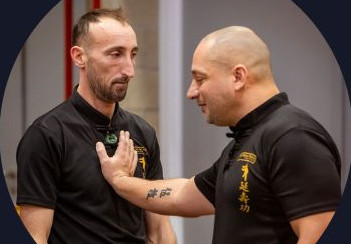Yan Shou Gong

Since my teens, I have had an interest in the Martial Arts, and practiced Nanbudo for a few years back then. More recently, I took up Kung Fu. However, it was the internal aspect of Kung Fu that particularly interested me, and this was hard to pin down.
An old friend, who had demonstrated internals to me in the 1990s (thoroughly intriguing me in the process), told me I needed to research Nei Gong. I tried an online course, but the 3+ year curriculum assumed starting from scratch and I soon lost interest.
Then, my Kung Fu teacher mentioned Master Yap and his online course introducing Yan Shou Gong. This was different. Short forms, easy to learn, but with immense depth, and also easily testable. My teacher and I undertook the online course, and then went on a workshop in Amsterdam with Master Yap.
This workshop was fascinating. Practicing testing the movements in Yan Shou Gong forms with a partner, I was able to see how they work best when you aren’t actually doing anything! Occasionally, I would watch my partner bounce across the room, and simply couldn’t explain why - I felt nothing happening. Since, I have learned that this is the point: through relaxation, and becoming “sung”, we become more able to use our structure to move others. The more strength they give us, the easier it is to move them!
As an aside, why would a reader of this blog be interested in Yan Shou Gong? That’s surprisingly simple. Yan Shou Gong is a delightful way of triggering prediction error events in both the student and their partner. We as humans naturally make predictions that strength is the necessary to move resistent forces (in this case, another person). Yan Shou Gong teaches us that this is not actually the case. Yet, at least in the early stages of learning, it remains a surprise whenever it works. And it seems to remain a surprise, regardless of the level of experience when you are moved by effective Yan Shou Gong.
After further training from Master Yap’s main student Lyndon Oudsten, Paul and I were granted Level 1 instructor status. Since then we have both begun the slow process of establishing regular classes (slow because starting anything is slow, but also because internals are easy to demonstrate in person, but hard to document in words).
Yan Shou Gong was formulated last century by two Kung Fu Grandmasters, who recognised the risk of the world loosing their Nei Gong skills, because it took so much time to learn. So, they distilled down their forms into 36 simple to learn, but extremely dense and rich forms and named them Yan Shou Gong: the Art of Longevity, in recognition of the health benefits of internal work.
I have myself seen significant benefit. I have a weak lower back, and have been able to recover far faster when it goes out because of what I have learned. I have been able to release tension in my back through alignment and allowing energy to flow more along more wholesome routes. And I have seen a significant reduction in my vertigo as I learn to ground and root myself.
Alongside the International site we also now have a UK Yan Shou Gong site. I highly recommend this delightful art that can be practiced in short windows of time, can benefit our health, help us defend ourselves, and also give us a range of cool party tricks with which to surprise our friends!